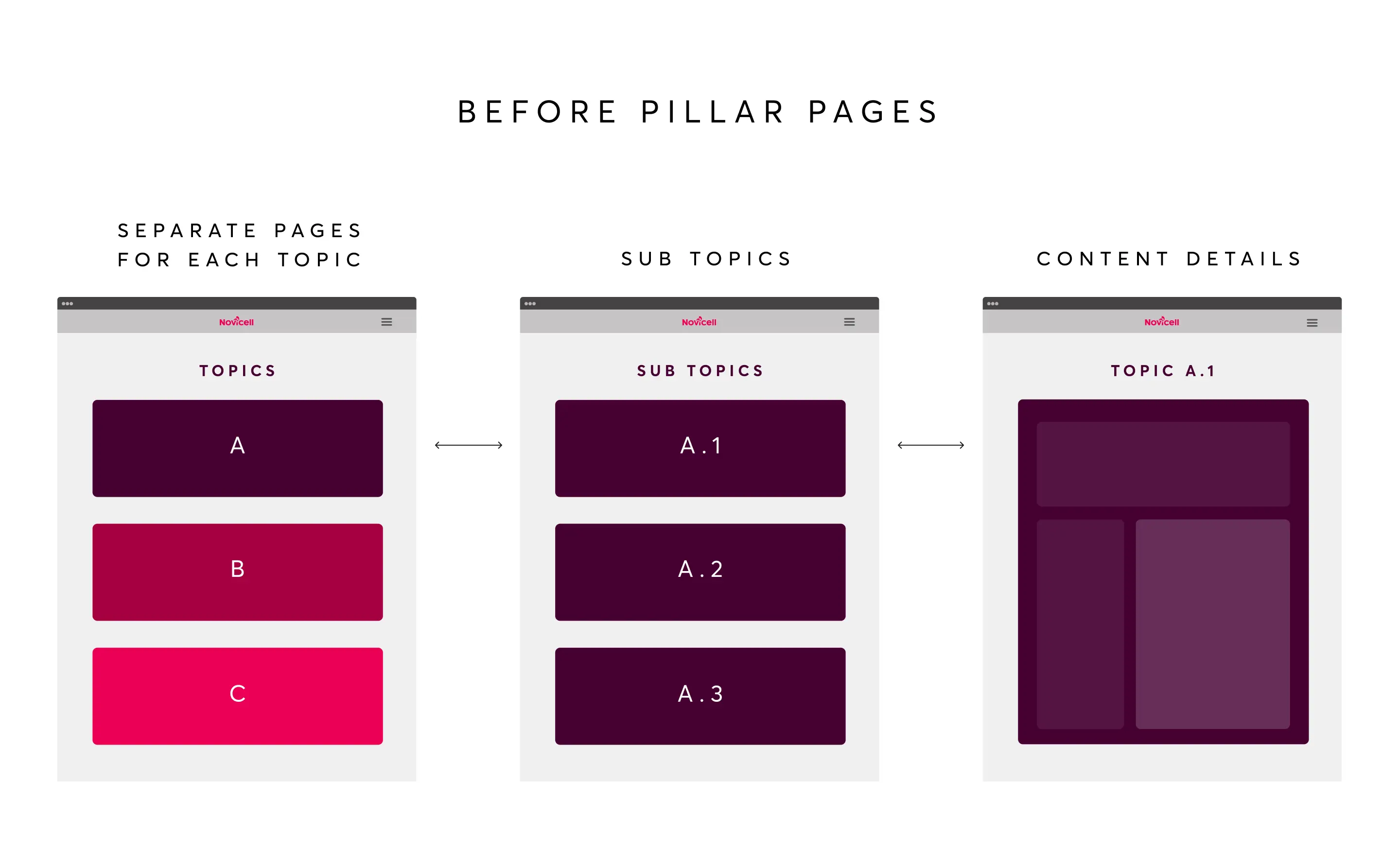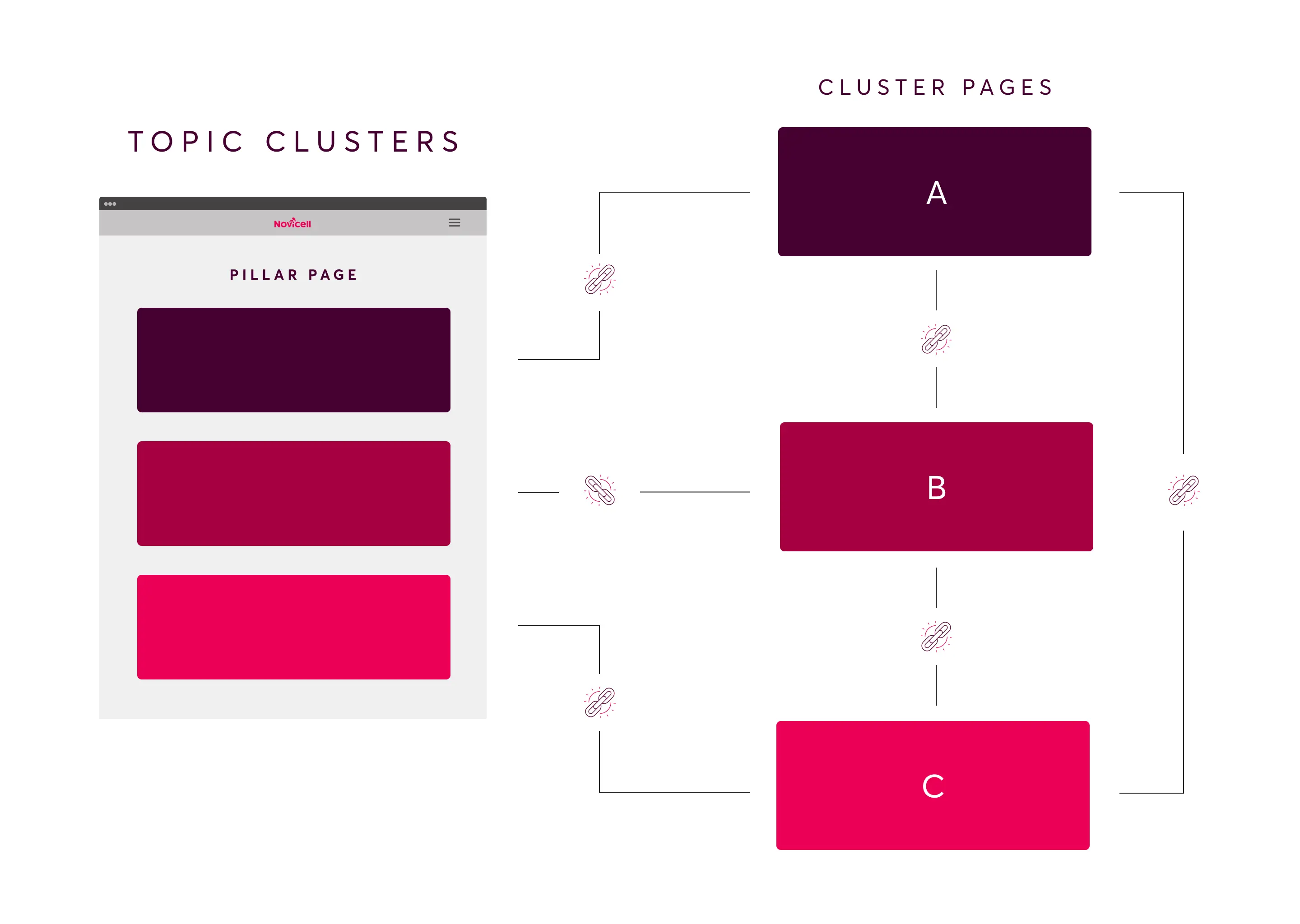Do you need help making your content rank well on Google? Would you like to boost your website traffic and attract qualified leads? We got you sorted.
The knowledge behind search engine algorithms is constantly evolving and once again there has been a shift. It’s no longer mainly about selecting certain keywords to focus on but topics if you want to rank the best way possible in search engine results.
The aim of this article is to answer some of the most common questions related to pillar pages, topic clusters and content and why this is a useful strategy to arrange and make your content accessible to your audience.
Keywords vs topics
The way people use search engines has changed. Previously, keywords did the job, but now people are typing longer and more specific search queries to find the most relevant information. For example: If you want to create a gym membership, most people will search for long-tail keywords: “Gym with yoga classes in London“ rather than just “gym”.
Because of this, search engines have developed from interpreting single keywords to understanding and connecting the meaning behind longer search queries.
This is seen on Google and other search engines when they try to read the searcher’s mind. For instance, if you search “body lotion”, Google will now also show you “face cream” to ensure you find exactly what you are looking for.
With these changes, companies and bloggers must follow suit and rethink the way they create content to keep being visible on the search engine result page (SERP).
So, now on to explain how to benefit from this information in your daily SEO work.
Pillar page untangled
As the name pillar page indicates, this page works as a cornerstone and important topical pillar in your content marketing. More elements will be presented in the forthcoming text to fully understand this concept, like topic clusters and cluster content.
First, you have the pillar page, which is a page that contains summaries of all the main content you want to convey. The pillar page describes the overall details of the topic and is very broad, though held within your overall topic. It’s often significantly longer than a typical blog as it covers all the sub-topics within the larger topic you want to rank for.
Since the pillar page is quite long, it can be a good idea to divide it into sections to make it easier to digest. Also, adding plenty of headers and bulleted lists alongside visual content such as videos and images will be beneficial. Designing a page like this is an effective way to break up heavy content. It’s more visually pleasing for the visitor, plus people will engage with your page for longer.
For more tips on creating an appealing website, we have composed a checklist of 8 things to consider.

What is cluster content?
The cluster content is in-depth pages about topics or sub-topics mentioned on the pillar page. So, where pillar pages give you a comprehensive overview and present the different branches of the matter, it leaves room for further depth and details in the cluster content.
This is also why it’s possible to divide the pillar page into different parts, where each piece hyperlinks to a new site that dives deeper into the specific area: The cluster content.
However, it also goes the other way: While the pillar page links to the cluster content, it's also very important that the cluster content pages link back to the pillar page. By doing this, you have made it easier to navigate between them and gathered your topics in the same universe: You have created a topic cluster.
What is a topic cluster?
As the name indicates, a topic cluster consists of several pieces of content concerning the same topic. So, you will create several texts instead of only writing one text about a certain topic. The content can be blogs, articles, and various other pieces within the same topic. As we mentioned earlier, the individual piece of content is called cluster content.
It's not necessary to write all the texts for the topic cluster at once. It may be an ongoing and long-term process – actually, regular updates to pages are more encouraged and shows Google that your pages are still up to date with the latest news within your subject.
There is no correct answer to how many pages of cluster content should exist - it depends on the depth of the topic, though a useful rule of thumb is to have between 15 and 30 related cluster contents to each topic cluster.
Confused? We got you!

Wrapping it up, topic clusters consist of two elements:
- The pillar page
- The supporting cluster content pages
The topic cluster is based on the pillar page, which covers all the aspects of the topic extensively and is the central page. From there, the hyperlinked cluster content supports the pillar page and is related to it by covering different sub-topics in depth.
This link structure shows Google that you possess a breadth of information on this topic due to your web of expert knowledge, as well as serves the purpose of providing relevant and easy-to-navigate content to the reader – whether that is a quick summary (on the pillar page) or an in-depth article (on the cluster content).
Additionally, it helps the algorithm identify the topic clusters: When one page performs well, Google will reward you and boost the entire cluster due to the connection between them.
A change of focus
By creating topic clusters, you change the focus from keywords to topics. This goes hand in hand with the current development in how people use search engines, as described at the beginning of the text.
To implement this strategy, you must first decide on the broad topic you want to rank for – typically closely related to your business or industry. Map out all the sub-topics within this and prioritise your efforts according to where the value is highest. Afterwards, you create cluster content based on keywords linked to the chosen topic, where the topic will help you choose your keywords more effectively.
Yet, be careful of keyword stuffing. This is when incorporating an overload of keywords to your page that, in the end, makes the text hard to understand and does more damage to your SERP ranking than good. Google will figure it out and punish you for prioritising rankings over readers.
To summarise, this isn’t a goodbye to keywords but an introduction to a new strategy for using them in your content. In this advantageous pillar page strategy, choosing your topic is step one, and next, picking the relevant keywords to your cluster content.
Tracking the results
It's no secret that it takes quite some time and effort to implement these structural changes on your website. For that reason, defining your goals and measuring the outcome is important. And how do you do that? For your pillar pages, keep an eye on these factors:
- Total page visits
- Time on page
- Bounce rate
- Conversions
In addition to measuring your pillar pages, you can also compare your different topic clusters to see which ones drive the most traffic and leads to your page.
Still, seeing the actual results doesn’t happen overnight. Bear in mind that it might take a couple of months to see your work pay off and for the organic traffic to grow. If you want to speed up the process, consider promoting your pillar page via paid advertising.
By observing your pillar page's performance, you can continuously adjust and optimise your content to maximise SEO and lead generation. You can revise the pages that aren’t performing well and take inspiration from the ones that achieve success.
Significant business benefits
Being up-to-date with your SEO strategy is necessary if you want to be found by potential customers and clients. Therefore, it’s important to adapt to the new way consumers search. Using topic clusters and building pillar pages will help you capture the best possible position in search engines and increase traffic to your site.
Furthermore, the strategy helps to provide answers in a clear and efficient way and, with that, a better user experience. At the same time, you cover as many searchers as possible because of your informative pillar page. You will make your customers stay on your page for longer and decrease the bounce rate. On top of that, creating a pillar page will promote your broad knowledge and expertise while showing ownership of a certain topic. Yet most importantly, creating a pillar page will boost your SEO performance.

